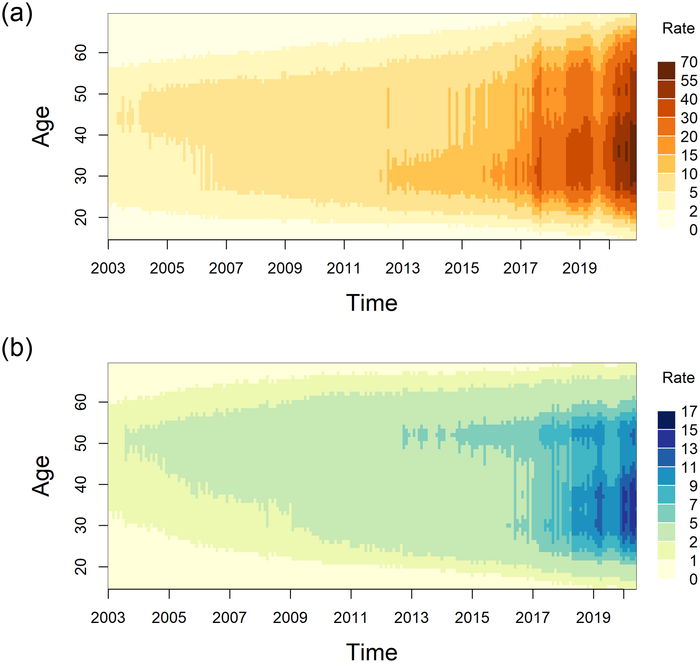From 2003 through 2020, as opioid-related mortality in Ontario, Canada increased five-fold, the age distribution also shifted downward – with rates now peaking for people in their mid-30s – according to a new study published this week in the open-access journal PLOS ONE by Patrick Brown of University of Toronto, and colleagues.

Credit: Paul et al., 2022, PLOS ONE, CC-BY 4.0 (https://creativecommons.org/licenses/by/4.0/)
From 2003 through 2020, as opioid-related mortality in Ontario, Canada increased five-fold, the age distribution also shifted downward – with rates now peaking for people in their mid-30s – according to a new study published this week in the open-access journal PLOS ONE by Patrick Brown of University of Toronto, and colleagues.
Opioid-related mortality is a critical public health issue in North America, with rates of opioid-related deaths having increased drastically over recent years. Updated data on the demographic makeup of deaths and how they have changed over time is crucial to tailoring public health interventions.
In the new study, the researchers used mortality data from the Office of the Chief Coroner for Ontario, the most populous province in Canada. Opioid-related deaths were defined as deaths where acute drug toxicity involving opioids was considered as directly contributing to the cause of death.
Between 2003 and 2020, there were 11,633 opioid-related deaths in people aged 15 through 69. Overall, 72% of opioid-related deaths during the 18-year study period were male, and accidental deaths accounted for 82% of the deaths.
Opioid-related mortality rates jumped more than fivefold over this period. They increased substantially for both sexes and across all ages over time, with a downward shifting age distribution for both sexes. Using a novel Bayesian modelling approach, the authors estimated that in 2003, the maximum mortality rate for males, of 5.5 deaths per 100,000 person-years (95% CI 4.0-7.6), was seen around age 44, while in 2020, the maximum of 67.2 deaths per 100,000 person-years (95% CI 55.3-81.5) was at age 35. For females, the greatest mortality rates also shifted to younger ages; in 2003 the peak of 2.2 deaths per 100,000 person-years (95% CI 1.5-3.2) was at age 51, while in 2020, the peak of 16.8 (95% CI 12.8-22.0) was at age 37.
Based on the observed data and resulting models, the researchers hypothesize that opioid-related mortality among the younger population will continue to grow. Targeting strategies to address opioid-related mortality among individuals in the 25 to 44-year age group is of greater importance than in the past, they conclude.
The authors add: “Opioid-related mortality has been rising in Ontario, Canada since 2003, and after a brief decline in part of 2019, the upward trend resumed in the 2020 COVID-19 era. Using a novel Bayesian model and high-frequency data from the coroner’s office, we show that the age distribution of opioid-related mortality has shifted gradually over 18 years from being highest among the 45 to 54-year age group, to being highest among the 25 to 44-year age group.”
#####
In your coverage please use this URL to provide access to the freely available article in PLOS ONE: https://journals.plos.org/plosone/article?id=10.1371/journal.pone.0265509
Citation: Paul LA, Li Y, Leece P, Gomes T, Bayoumi AM, Herring J, et al. (2022) Identifying the changing age distribution of opioid-related mortality with high-frequency data. PLoS ONE 17(4): e0265509. https://doi.org/10.1371/journal.pone.0265509
Author Countries: Canada
Funding: The authors received no specific funding for this work.
Journal
PLoS ONE
DOI
10.1371/journal.pone.0265509
Method of Research
Observational study
Subject of Research
People
Article Title
Identifying the changing age distribution of opioid-related mortality with high-frequency data
Article Publication Date
20-Apr-2022
COI Statement
The authors have declared that no competing interests exist.




